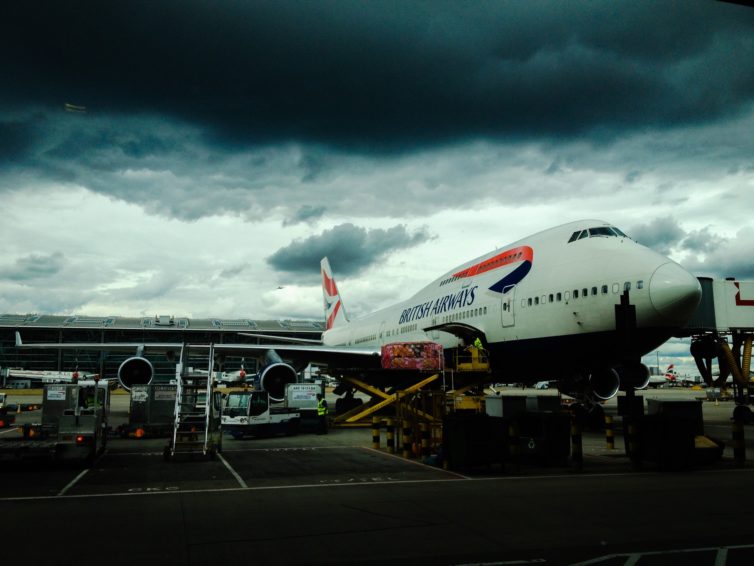
A British Airways 747 under dark skies – Photo: Francois Van
Here is something that I wasn’t expecting: staying up from 1:30 am to 5:30 am on a Saturday morning to take an online class, from British Airways, that helps people overcome their fear of flying. However, when I learned about their Flying With Confidence program, I couldn’t help but be curious.
I have never really feared flying much. Sure, there might be some hairy moments, but I typically enjoy when the flight gets a little turbulent. However, I know this is not the case for many people.
A fear of flying has always been rational to me. Not only are you in a tube flying 35,000 feet in the air, but when an airline is involved in an incident, it becomes an international story. Sure, one can share data about the safety of flying and use the classic line ’œyou are more likely to die driving to the airport,’ but those sorts of things rarely have a major impact.
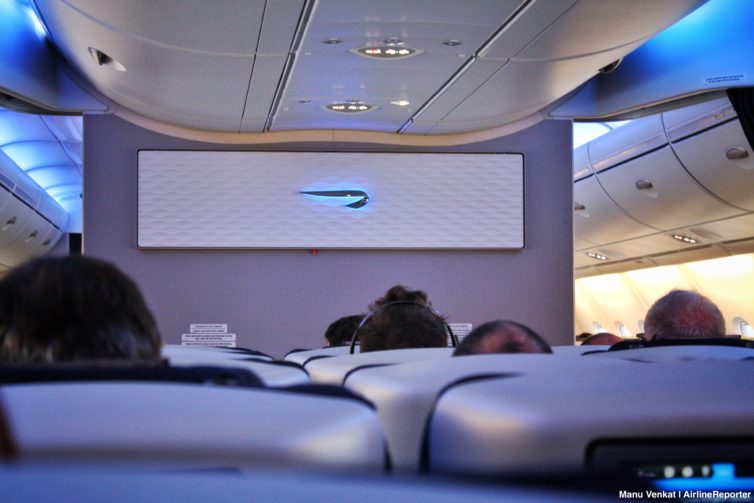
For many folks reading this story, this view is exciting, but for others it can be terrifying
Some passengers with flying phobias are able to painfully push through it, but others write off flying altogether. For those looking to overcome their fears, there are some legitimate ways to get help.
I was excited to see what the British Airways Flying with Confidence program had to offer, and I was interested to get more insight. I actually learned a few things that would not only help me with with future rough flights, but also some other phobias that I might or might not have (*cough* gnarly spiders *cough*).
ABOUT FLYING WITH CONFIDENCE
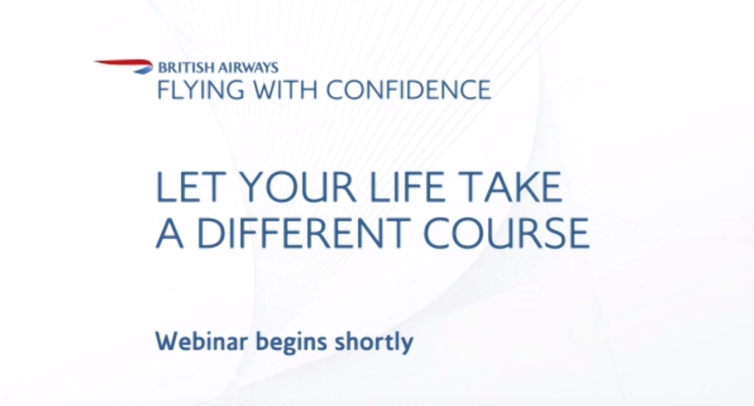
The introduction slide for the British Airways presentation – Image: British Airways
British Airways has been offering the Flying with Confidence course for about 35 years, and they have helped over 50,000 people. They claim to have a 98% success rate, and I can believe it. They offer a staff of over 40 people who assist from a number of different angles; from pilots to flight attendants, to air traffic controllers — all able to answer questions about the flying process.
Historically, they have only offered in-person courses at London Heathrow & Gatwick, Edinburgh, Glasgow, Manchester, Dubai, and Johannesburg. However, due to COVID, they started providing an online option. I felt lucky enough to participate in the first online class.
There was still an in-person session that took place in London, which had about 40 attendees safely spread out among two rooms — they typically have over 100 participants. The course was completed over two days. The first day was a presentation that went over the different aspects of flight and the psychology of flying phobias. On the second day, people boarded a British Airways Airbus A319 and took a flight to nowhere. How cool is that?
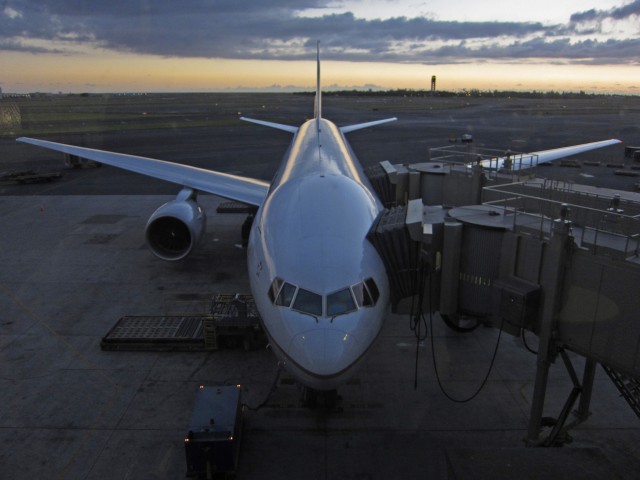
Boarding a 777 flight – Photo: Alan Light | Flickr CC
’œYou’re a travel writer,’ people say to me. ’œBut you’re afraid of flying? How does that work?’
It doesn’t. A terrible experience happened to me, where a flight from Lagos, Nigeria, to Accra, Ghana, kept losing altitude for 30 minutes straight. Storm clouds surrounded us, and I couldn’t see anything. The captain didn’t come on the loudspeaker to say there would be turbulence, or sorry for the inconvenience, or that we were totally safe and not crashing to the ground due to a terrible malfunction. People were screaming the entire time. I was about to vomit when finally I saw a village through the thick, white clouds and realized we were safely landing.
I’ve never been the same since. I’ve gotten better, sure I usually have to fly in order to travel but I’m not totally cured. Not many people are sympathetic to this fear, however, and it sucks. I find these are good ways to upset someone who has a fear of flying.
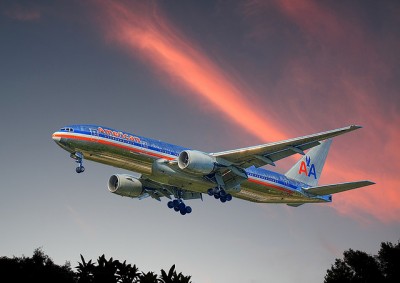
Wonderful shot of American Airlines Boeing 777-200ER
I hear from a lot of aviation enthusiasts, “why are people afraid of flying? It is the safest transportation out there.” I have heard all sorts of fascinating statistics on how much safer flying is than driving, but I wanted to check them out for myself and share what I found.
A lot of people feel they have a lack of control while flying. They are sitting in a seat 30,000 feet in the air and their life is in the hands of the pilot and luck. Many feel they have full control in their automobile and are able to avoid a deadly crash. Yes, there are many auto incidents that can be avoided, but in most fatal accidents, there is nothing the driver can do.
First, some raw information from government websites:
Data from NHTSA (2008):
Total Auto-Related: 34,017
Deaths to Drivers: 19,220
Deaths to Auto Passengers: 7,397
Pedestrian Deaths: 4,378
DATA FROM FRAOSA (2008):
Total Train Related Deaths: 800
Deaths on a train: 3
Ok you ready for this?
DATA FROM NTSB:
Deaths on 14 CFR 121 (Airlines)…
From 1982-Present: 2924
In 2009: 45
In 2008: 0
In 2007: 0
In 2006: 47
Deaths on 14 CFR 135 (Commuters)…
From 1982-Present: 364
In 2009: 0
In 2008: 0
In 2007: 0
In 2006: 1
The raw numbers are pretty interesting all on their own. I was hoping to compare 2008 stats with all transportation methods, but there just weren’t any airline-related fatalities in 2008. It is amazing that in 2008 34,017 Americans died in car related accidents, but in 28 years from 1982-2010 only 3,288 Americans have died from airline-related accidents. Just think about that… statistically, that means it would take over 117 years of airline fatalities to equal the same number of auto-related deaths just in 2008.
Although telling already, I also wanted to compare number of deaths per miles traveled by car versus airplane versus train. According to the Research and Innovative Technology Administration with the Bureau of Transportation Statistics, Americans in 2008 traveled 2,553,043,000,000 miles in cars, 583,506,000,000 miles via commercial aviation and 16,850,000,000 miles by rail. Doing the math, I looked at the number of deaths per 100 million miles traveled in the US:
TRAIN RELATED: 4.40
People being killed by a train in any fashion via FRAOSA
OTHER AUTO: 1.73
Motorcycles, pedestrians, auto related
AUTOS: 1.33
Only passenger vehicles
PASSENGER TRAIN: 0.13
People dying on the train via FRAOSA
COMMERCIAL AIRLINES: 0.0077
2009: 0.0077
2008: 0.0000
2007: 0.0000
Once again, it is hard to compare, since so many years for airlines have zero deaths. This means the average American is 190 times more likely to die in an auto accident in 2008 versus an automobile accident per 100 million miles traveled. So why do people concentrate so much on airline-related deaths versus others?
Well, the media and public really attach on to an airline crashing anywhere in the world. Heck, you normally will hear when an airline needs to make an emergency landing. However, you barely hear a peep about an auto-related death on the local news, let alone an auto death happening somewhere else in the nation or world. This slanted coverage gives passengers this false idea that airlines are inherently unsafe and people die all the time. Also, where an average of about 90 people die per day in a car related accident, they are spread through out the day and all over the country. It isn’t as shocking as 30-250 people dying at one time in an airline incident.
This just helps to reinforce how amazing air travel is in the US. What other transportation can you use in America today that is safer than that… other then not leaving your home? These are very complex machines, constantly flying as cheap as possible at all hours of the day. It truly is amazing more incidents don’t occur. Those that ask for the “good ‘ol days” of travel, should remember how much safer your flight is now than it was just 50 years ago.
On the other side of this, should airlines and airport continue to put millions of dollars into safety, when the industry is already very regulated and comparatively very safe? Is there such a thing as spending too much money to make air travel “too safe” or are the costs worth it?
Anyhow, getting off my soapbox, I know if you are afraid of flying, seeing these statistics probably isn’t going to help you feel too much at ease. However, next time you hit a bit of turbulence, think of how few people die each year flying and that there is a really, really really, really, really good chance you will be a.o.k!
Image: Luis Argerich

Branson greeting you to calm your fears. From Virgin Atlantic's website
Are you afraid of flying? For $4.99 you can download an iPhone app that has a 98% success rate with calming people’s fears. According to a Boeing survey, one of every three Americans is either anxious or afraid to fly.
The iPhone app starts out with an introduction from Richard Branson, president of Virgin Atlantic, trying to calm people’s fears of flying. Then users can learn about the flying process, what to expect, a frequently asked questions section, and even a “Fear Attack” button in case you need quick breathing exercises to calm your nerves.
“Our first iPhone app will bring the benefits of our successful Flying Without Fear course to millions of people around the world who are now using mobile technology to make their lives better,” Branson said.
And don’t take my word for it! Whoopi Goldberg stated, “I was a sceptic. I hadn’t flown in 13 years but after doing their program, I understood that while my fear was real, there were many things I didn’t know or had misinformation about, which they were able to clear up. So what happened? The program works. I now fly. It’s that simple.” And you know if Whoopi can do it, so can you!
Even if you don’t fear flying, you get 2,000 Virgin Atlantic Flying Club miles when joining the program, which might be worth the $5 all on its own!
Thanks Mathu for the tip!
follow us via | web | twitter | email | rss |





